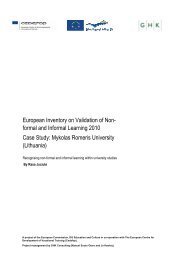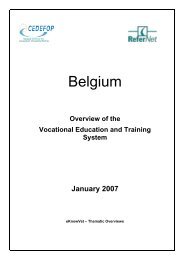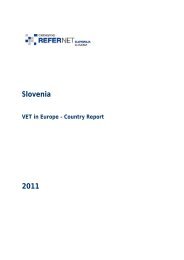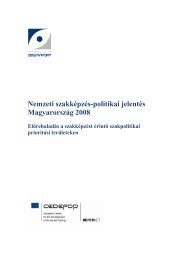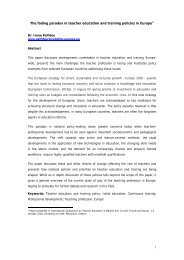PROFF – Professionalisation of VET teachers for the future - Europa
PROFF – Professionalisation of VET teachers for the future - Europa
PROFF – Professionalisation of VET teachers for the future - Europa
Create successful ePaper yourself
Turn your PDF publications into a flip-book with our unique Google optimized e-Paper software.
is characterised by isolation: schools from parents and <strong>the</strong> community and fromeach o<strong>the</strong>r; <strong>teachers</strong> and learners in isolated classrooms.’To be effective, this coordination requires new ‘networking’ and interdisciplinary skills.Most changes just described were initiated not from within, but from outside <strong>the</strong> <strong>VET</strong> system,as a result <strong>of</strong> political decision and/or <strong>of</strong> pressure from industry. Often <strong>the</strong>y challenge <strong>the</strong>teacher’s view <strong>of</strong> <strong>the</strong> <strong>VET</strong> system, <strong>of</strong> <strong>the</strong>ir own role and <strong>of</strong> <strong>the</strong> way <strong>the</strong>y teach. And in somecases <strong>the</strong> changes contrast with <strong>teachers</strong>’ ‘implicit’, ‘tacit’ knowledge <strong>of</strong> how best to behavein specific teaching situation. This situation is made worse when government <strong>–</strong> ormanagement <strong>–</strong> fails to provide <strong>teachers</strong> with <strong>the</strong> time, or <strong>the</strong> financial resources to retrain.Where <strong>the</strong>se resources are not available <strong>teachers</strong> (and <strong>the</strong>ir managers) will give priority to <strong>the</strong>needs <strong>of</strong> <strong>the</strong>ir students ra<strong>the</strong>r than to <strong>the</strong>ir own training. In short, and as a result <strong>of</strong> all <strong>the</strong>sefactors, whole-hearted teacher acceptance <strong>of</strong> change cannot be taken <strong>for</strong> granted and teacherresistance to change is one <strong>of</strong> <strong>the</strong> most significant threats to <strong>the</strong> success <strong>of</strong> <strong>VET</strong> re<strong>for</strong>m.In this setting, a key goal <strong>of</strong> many teacher training programmes is to give <strong>teachers</strong> a sense <strong>of</strong>‘ownership’ in <strong>the</strong> new system <strong>–</strong> providing <strong>the</strong>m with <strong>the</strong> skills and qualifications to play anactive role in its development. In at least one case (that <strong>of</strong> <strong>the</strong> Dutch institutes <strong>for</strong> vocationaltraining and adult education (ROCs)) management believes that innovative trainingprogrammes are essential to prevent an exodus <strong>of</strong> experienced, but underqualified staff.3.3. Target groupsThe key target group <strong>for</strong> teacher and trainer training consists, by definition, <strong>of</strong> pr<strong>of</strong>essionaleducators working in vocational schools, private companies and public organisations. One <strong>of</strong><strong>the</strong> most important results <strong>of</strong> <strong>the</strong> case studies is, however, that effective human resourcedevelopment in <strong>VET</strong> requires more than this. Managers <strong>for</strong> <strong>the</strong> programmes examined in <strong>the</strong>case studies were aware that actors at any particular level in an organisation have tounderstand <strong>the</strong> functions <strong>of</strong> o<strong>the</strong>r actors. In <strong>the</strong> Finnish META programme, <strong>for</strong> example,training was provided not only to <strong>teachers</strong> and workplace instructors, but also to managers.Again in Finland, Telkkä created a twinning arrangement between <strong>teachers</strong> and workplaceinstructors deliberately designed to create synergy between <strong>the</strong> two groups. In <strong>the</strong> Danish‘re<strong>for</strong>m competence project’, <strong>the</strong>re was a clear perception that changes are easier toimplement if training involves all groups <strong>of</strong> personnel with a stake in <strong>the</strong> changes. Especiallyimportant is middle management <strong>–</strong> which, without adequate training is likely to hold up <strong>the</strong>implementation <strong>of</strong> re<strong>for</strong>m. In <strong>the</strong> Dutch ‘dual trajecten bve’ project, training was provided <strong>for</strong>educational assistants, instructors/trainers and coaches in vocational training: new pr<strong>of</strong>essionscreated by <strong>VET</strong> re<strong>for</strong>m. The Italian HEP programme, took this approach a step fur<strong>the</strong>r,focusing exclusively on executives and managers from public and private vocational centres,employment centres, regional and provincial administration and trade union organisations.O<strong>the</strong>r programmes with mixed target populations include <strong>the</strong> Portuguese programme19



